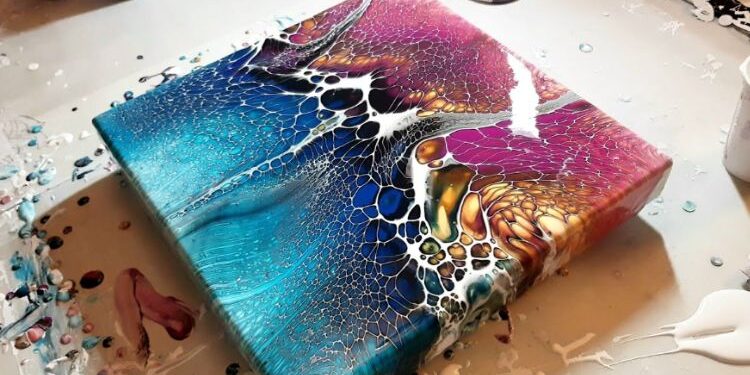Acrylic pouring is a popular art form that involves pouring acrylic paint onto a surface to create unique and beautiful designs. While it may seem like a simple process, proper surface preparation is crucial to achieving the desired results. In this essay, we will explore the importance of proper surface preparation in acrylic pouring.
Surface preparation is the process of preparing a surface for painting or other forms of art. In acrylic pouring, surface preparation involves cleaning and priming the surface to ensure that the paint adheres properly and does not peel or crack over time. Proper surface preparation is essential for achieving a smooth and even finish, preventing paint from bleeding or running, and ensuring that the colors remain vibrant and true.
One of the most important steps in surface preparation for acrylic pouring is cleaning the surface. Any dirt, dust, or debris on the surface can interfere with the adhesion of the paint and cause it to peel or crack over time. To clean the surface, use a damp cloth or sponge to wipe away any dirt or dust. If there are any stubborn stains or marks on the surface, use a mild soap solution to clean them off.
After cleaning the surface, it is important to prime it before applying any paint. Priming helps to create a smooth and even surface for the paint to adhere to. It also helps to prevent any bleeding or running of the paint. There are several types of primers available for acrylic pouring, including gesso, matte medium, and clear gesso.
Gesso is a popular primer for acrylic pouring because it creates a smooth and even surface that is ideal for pouring. It also helps to prevent any bleeding or running of the paint. Matte medium is another popular primer that creates a slightly textured surface that can add depth and dimension to your painting. Clear gesso is similar to regular gesso but dries clear, making it ideal for creating transparent layers in your painting.
Once you have cleaned and primed your surface, you are ready to start pouring your paint. However, there are still some important considerations to keep in mind when preparing your surface for acrylic pouring.
One important consideration is the type of surface you are using. Acrylic pouring can be done on a variety of surfaces, including canvas, wood panels, paper, and even ceramics. However, each type of surface requires different preparation techniques. For example, canvas should be stretched tightly over a frame before priming to prevent any sagging or warping during painting.
Another consideration is the temperature and humidity of your workspace. Acrylic paints are sensitive to temperature and humidity changes, which can affect their consistency and drying time. To ensure that your paint dries evenly and does not crack or peel over time, it is important to work in a space with consistent temperature and humidity levels.
The most significant benefit of acrylic pouring is its accessibility. Unlike other forms of art that require extensive training or expensive materials, acrylic pouring can be done by anyone with basic supplies such as paint, a canvas, and pouring medium. This accessibility makes it an excellent form of art therapy for those who may not have access to traditional therapy or who may not feel comfortable expressing themselves through more conventional means.
Acrylic pouring also allows for a great deal of experimentation and creativity. There are countless techniques and variations that can be used to create different effects, from the use of different colors to the addition of various mediums such as silicone oil or alcohol. This experimentation can be incredibly freeing for artists who may feel constrained by more traditional forms of art.
Its creative benefits, acrylic pouring can also be a form of stress relief. The process of mixing colors and manipulating the paint can be meditative and calming, allowing artists to focus on the present moment and let go of their worries. This can be especially beneficial for those who struggle with anxiety or depression.
Another important aspect of acrylic pouring is its ability to foster community. There are countless online communities dedicated to sharing techniques, tips, and finished pieces, allowing artists from all over the world to connect and support one another. This sense of community can be incredibly valuable for those who may feel isolated or alone in their artistic pursuits.
Acrylic pouring also has practical applications beyond just creating beautiful pieces of art. It can be used in interior design to create unique accent pieces or even entire murals. It can also be used in crafting, such as creating custom phone cases or jewelry.
Despite all these benefits, some may still view acrylic pouring as frivolous or unimportant. However, it is important to remember that art has always played an essential role in human expression and communication. Acrylic pouring is simply another form of this expression, one that allows individuals to connect with themselves and others in new ways.
In addition to these considerations, there are also several techniques you can use during surface preparation to create unique effects in your painting. For example, you can use masking tape or stencils to create defined shapes or patterns on your canvas before pouring your paint. You can also use texture mediums or sandpaper to create interesting textures on your surface.
In conclusion, proper surface preparation is essential for achieving beautiful and long-lasting results in acrylic pouring. By cleaning and priming your surface before painting, you can ensure that your paint adheres properly and does not peel or crack over time. Additionally, by considering factors such as temperature and humidity levels in your workspace and experimenting with different techniques during preparation, you can create unique effects in your painting that will make it truly one-of-a-kind.









